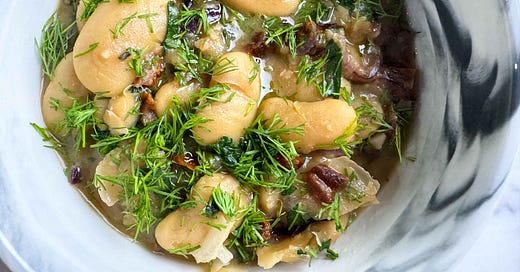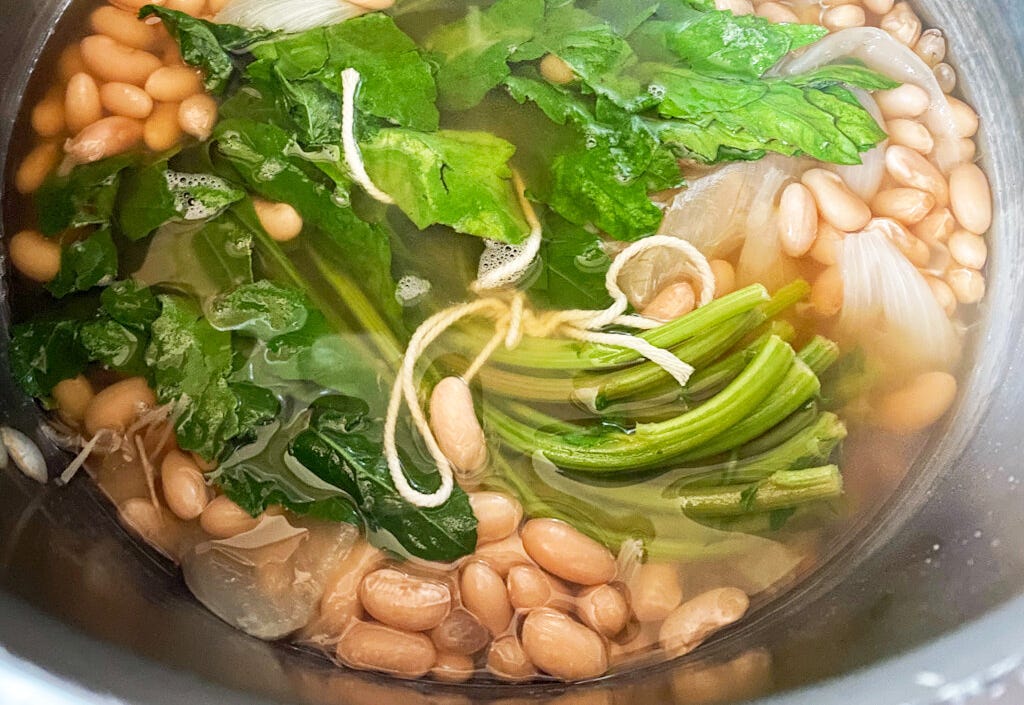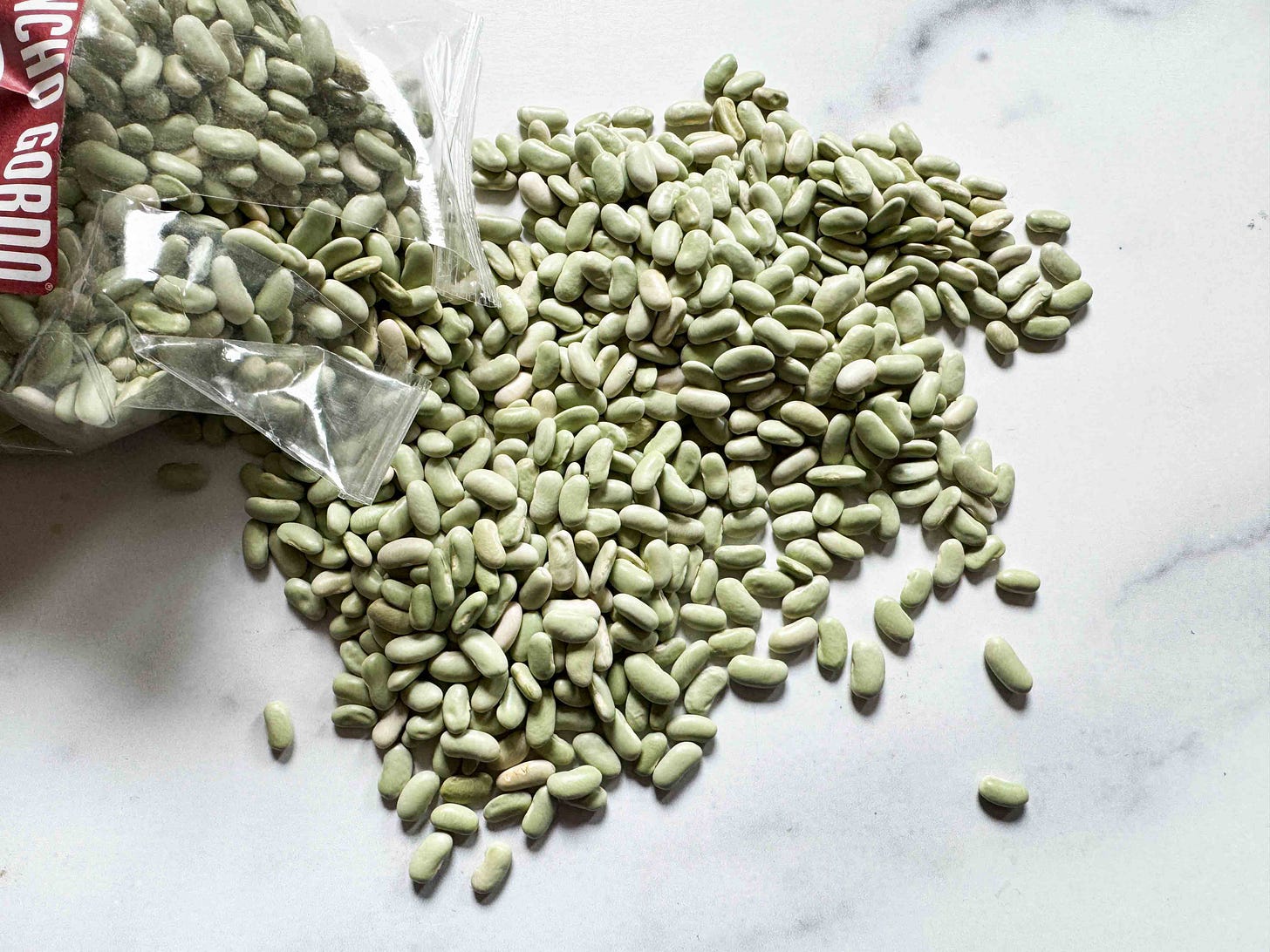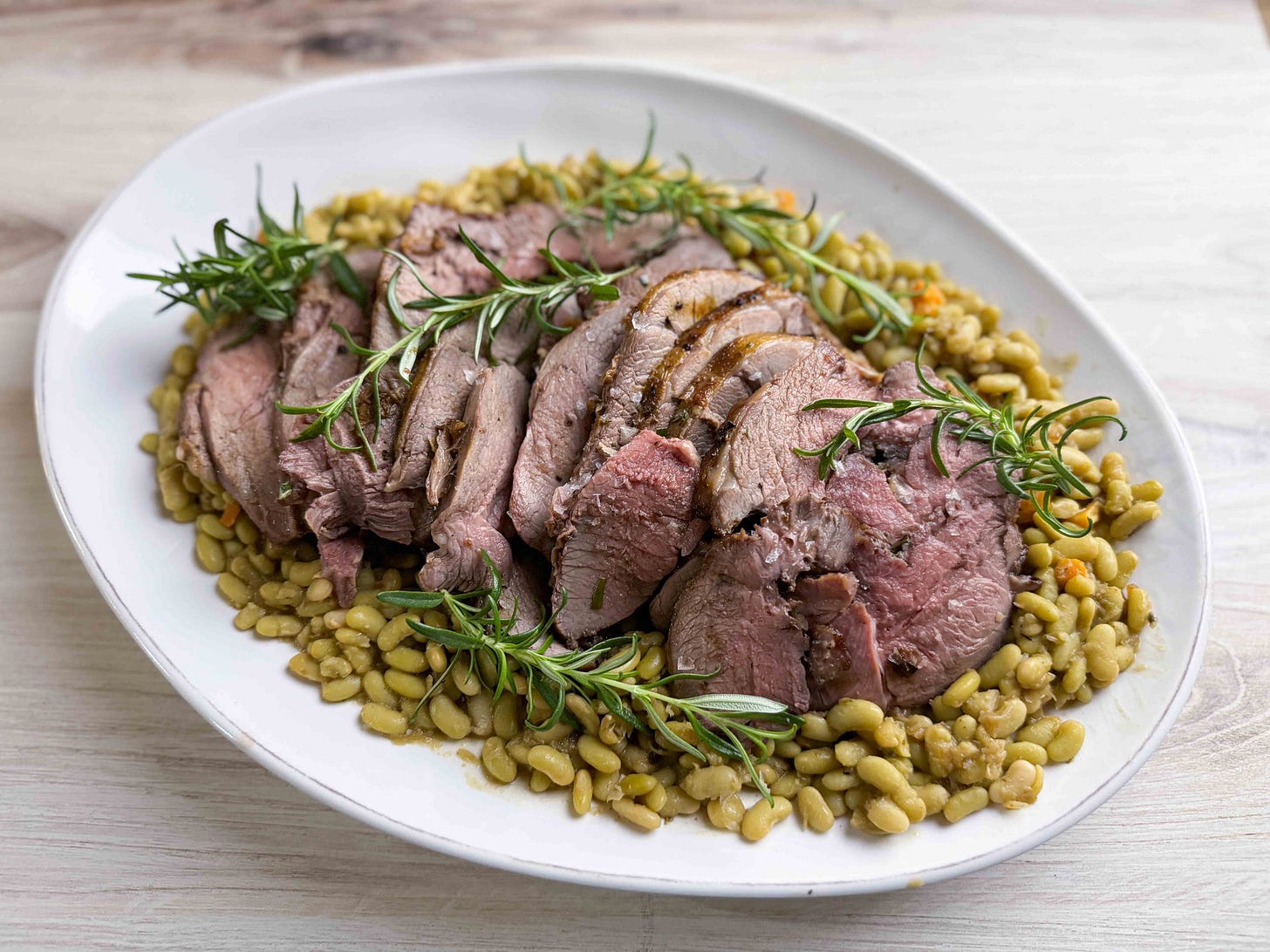Meetings with remarkable beans
Mayocobas, gigantes, Royal Coronas, flageolets. Plus cooking tricks and myths, a great new recipe and what the French eat with gigot d'agneau.
Happy Friday, vernal cook — and happy spring!
Luscious, creamy, almost succulent, almost (but not quite) bursting out of their skins: That’s the appeal of great beans. That they’re delicious as well as excellent for your health doesn’t hurt.
The marvelousness and boundless variety of pulses (another word for beans) explains the religion of Rancho Gordoism. The Napa-based supplier of dried beans offers retail therapy of the healthiest kind to fervent bean-worshipers. Yep, I’m one.
No sense, however, in being a bean snob. I enjoy ordinary canned beans as well as dried heirlooms, and keep them stocked in my pantry — they’re so handy when you don’t have time to simmer.
What’s that you say? I should pressure-cook those dried beans? Nah; bean there, done that. I tried some years ago to appreciate an InstaPot, but couldn’t find the joy in hermetic cooking followed by a disturbing upward expulsion of steam. All that pressure exacerbated anxiety rather than soothed it. I prefer to have something simmering low and slow on the back burner, gently filling the house with warm aromas.
So canned beans for me when I’m rushed. Butter beans, with their dashing Italian labels, I cannot resist. And guess what: As Camille Fourmont’s darling La Buvette cookbook suggests, you can just open the can, drain, drizzle with good olive oil “until the beans look shiny,” then finish with Maldon salt and a lot of grated lemon zest. Instant outstanding snack-apéro or spuntino; just add toothpicks for nabbing. Enlarge the photo below to get a sense of those dressed-up butter beans’ grandeur.
Seriously — that can of beans is the best $2.98 you’ll ever spend.
The outsized, extraordinary Royal Corona
Still, we all know that dried beans are a good deal nicer than canned (better texture, more flavorful). For the snack above, try the fabulous dried Royal Corona beans from Rancho Gordo. Uncooked, they look like they might be large limas, but simmer them to tenderness, and they swell to about twice the volume. Sometimes you can even see fine veins running through them; they almost look more animal than vegetable. So succulent. Yes, Royal Corona is one of the world’s outstanding beans.
Fortunately, my family shares my bean-amour. Best for all of us would be if I just put up a pot to simmer every morning — as abuelas do in Mexico — and we could enjoy them all the live-long day.
Before we get to our second featured bean, I’d like to bust a couple of bean myths, and offer a couple of cooking tips.
Myth: You always have to soak dried beans.
Fact: You never have to. You can just rinse them, pretend to sort them (in all my bean years I’ve never found anything to remove), then boil them to creamy tenderness. You may want to soak certain beans (Royal Coronas, flageolets) so they cook quicker and a litttle more evenly, but it’s not necessary. Black beans apparently lose flavor when you soak them.
Myth: You should only add salt to the water at the end or near the end of the cooking time because salting makes the beans burst.
Fact: Salting beans early does not adversely affect them; in fact it improves the flavor and helps keep their skins intact. Serious Eats, which studied the question, says to add a tablespoon of salt to each quart of soaking water if you do soak. Whether or not you soak, add about half a teaspoon of salt when you start cooking.
Which takes us to our next bean:
The dreamy, creamy mayocoba
This small, shiny-ish, pale yellow (when raw) bean from Mexico — also known there as peruano or canario (pale yellow!) — is my bean of choice for vegan frijoles de olla. Thin-skinned and tender, mayocobas cook up surprisingly quickly and incredibly deliciously. Depending on how fresh they are, you can sometimes have them on the table after simmering for an hour or so — without even soaking them.
You can cook them pretty plain — with just a few slices of white onion and a couple garlic cloves (and salt, of course), they’re outstanding. Add a couple dried avocado leaves or some fresh epazote, and they’re even better. Eat them as is, with some of their soupy broth, or turn them into vegan refried beans.
Here’s something that may surprise you: Mayocoba’s close cousin, the bayo bean, is as important in Mexico as pintos (which are most popular in the north) and frijoles negros (black beans, most popular in the south). In the state of Michoacán, mayocobas reign supreme, or so Regino Rojas, a Dallas-based chef who was born and raised there, tells me.
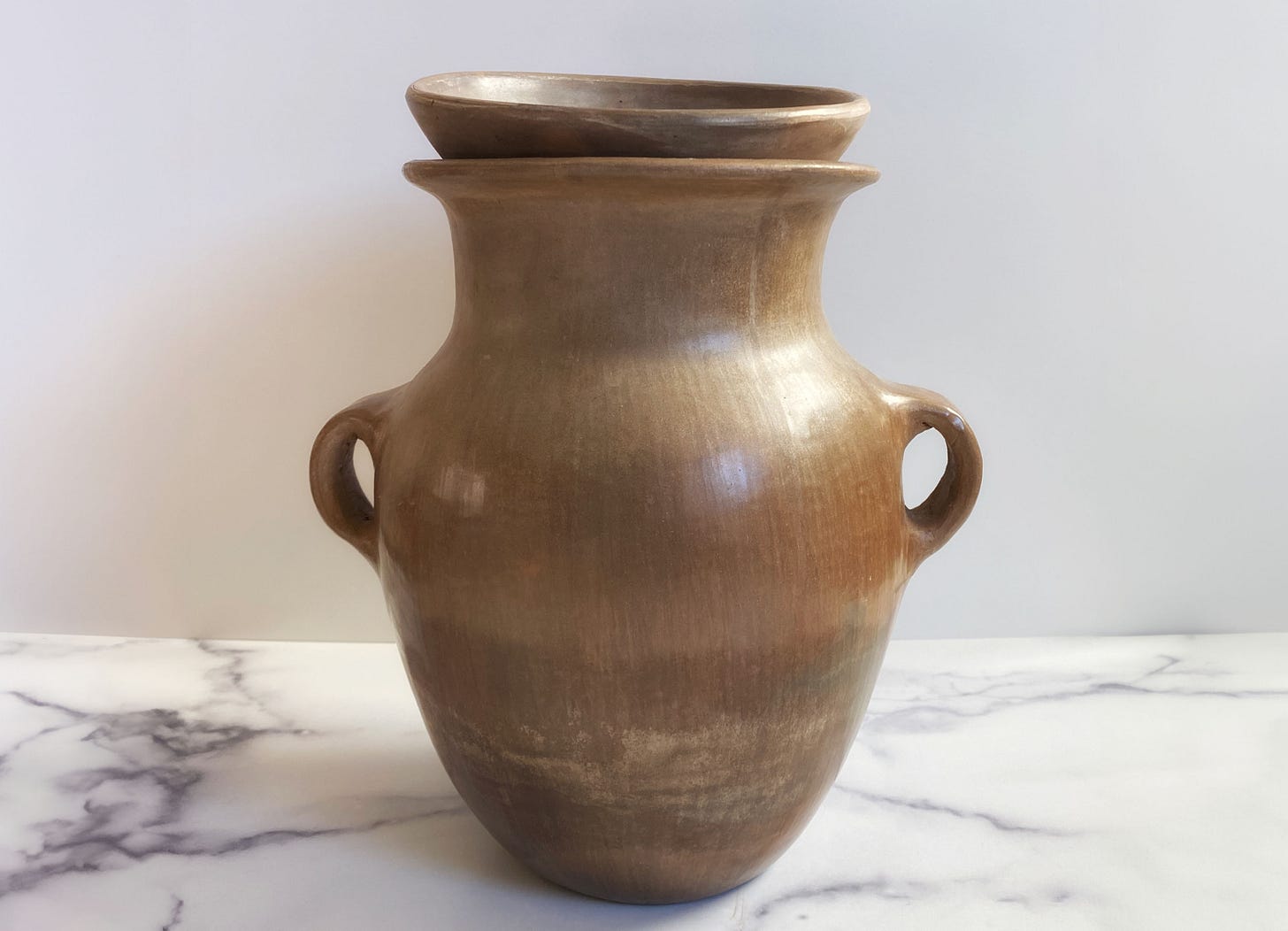
Flageolets: the ‘caviar’ of beans
Until two seconds ago, I had no idea a flageolet is a woodwind instrument.
It is also a bean — one of the most prized in France. About the size and shape of a kidney bean (maybe a wee bit smaller), flageolets are pale green, reflecting the fact that they’re harvested before full maturity (if you grow them, you can also eat them fresh as a shell bean). According to Rancho Gordo, although flageolets were developed in France — where they’re beloved with roast leg of lamb (gigot d’agneau) — their origin can be traced to the Americas, perhaps Oaxaca.
Cooking them is a breeze. I soak them the morning of, rather than the night before (and again, you don’t need to; they’ll just take a bit longer to cook). Here’s how:
• 1 pound / 454 g flageolets
• Salt
• Half an onion, peeled and studded with 3 cloves
• 1 carrot, peeled and cut in half
• 1 stalk celery, cut in half
• 2 bay leaves
• 3 thyme sprigs
—> Rinse the beans, put them in a pot and cover with a couple inches of water; add a tablespoon of salt. Soak 4 to 6 hours. Drain and put them back in the pot.
—> Bury the half-onion, carrots, celery, bay leaves and thyme sprigs in the beans. Cover again with a couple inches of water (I use filtered water at this point), add a teaspoon of salt, and bring to a boil over high heat. Don’t worry if vegetables pop out; you can push them down again later. Boil for about 10 minutes, then turn the heat to low to maintain a gentle simmer. Partially cover the pot and simmer, stirring now and then, until the beans are nearly tender. There should always be enough water so they’re brothy; if necessary, add boiling water as needed. Add salt to taste (probably another teaspoon or so), and continue cooking until they’re tender and creamy. Last time I did this, they cooked in about 90 minutes, but again, it depends on their freshness.
—> Fish out and discard the bay leaves and thyme sprigs, onion and celery. Retrieve the carrot pieces and, if you like, dice them and add them back to the pot. (Or you can eat them, along with the celery.) Taste the beans and adjust the seasoning, adding salt, if necessary. (If you’re going to eat these over several meals, be sure not to oversalt, and the saltiness will become more concentrated with reheating and loss of liquid.) Enjoy them as is (a vegan treat!), or use them to make Gigot d’Agneau Flageolets.
How to make Gigot d’Agneau Flageolets
Now that you have your cooked flageolets, you can serve them with roasted leg of lamb, French-style. Traditionally the dish is served for Easter; it would also be superb for Passover — or for any festive spring dinner for omnivores.
You’ll need a couple of cloves of confit garlic. To make that, peel five or six (or more or less) garlic cloves, put them in the smallest saucepan you have and cover them with olive oil. Bring to a simmer over medium heat, then reduce heat to the lowest possible and let them cook gently for about half an hour, till they’re very soft. Remove the garlic cloves, use two of them for the recipe below, and store the rest separately from the oil (for food-safety reasons; of course keep both refrigerated). You can keep them for a week or two.
In terms of meat-sourcing, if you happen to have access to locally raised lamb (as we do here in North Texas), that’s ideal (the Dorper lamb we get from a co-op, Capra Farms, is so good). But American lambs are larger than their New Zealand or Australian counterparts, so you might need to roast a larger leg (with a longer cooking time), or have the meat-cutter give you half a leg. If you can dress and tie the lamb four to six hours in advance and let it sit in the fridge (uncovered), so much the better, but it’s not necessary. Just make sure you bring the lamb to room temp for half an hour or an hour before roasting.
For the lamb:
• One boneless leg of lamb, about 3 1/2 to 4 pounds (1.5 to 1.8 kilos)
• 4 branches rosemary, leaves stripped off and chopped
• 1 teaspoon chopped thyme leaves
• 3 olive-oil-packed anchovies, chopped
• 2 confit garlic cloves
• Kosher salt
• Freshly ground black pepper
• 2 tablespoons olive oil
For the flageolets:
• 3 tablespoons olive oil
• 1/2 onion, cut into small dice (or chopped)
• 1 medium carrot, peeled and cut into small dice
• 3 sprigs thyme
• 2 cloves garlic, minced
• 1 recipe flageolets, drained — with the liquid reserved
For finishing:
• 1 medium shallot, minced
• 1/2 cup / 120 ml white wine
• Rosemary for garnishing
—> Unfold the lamb on a cutting board, and use the tip of a small knife to remove any hard fat you see between the muscles. Don’t remove fat covering the outside of the leg.
—> In a small bowl, combine the rosemary and thyme leaves, the anchovies, the confit garlic, a teaspoon of the salt and about half a teaspoon of the pepper. Use a fork to mash the garlic, and mix everything together. Spread the mixture as evenly as you can on the inside of the lamb, then roll it back up and tie it with butcher string to hold its shape. Set it on a sheet pan or plate and let it rest like that in the fridge for four to six hours if you can; if not, no worries.
—> Heat the oven to 375 degrees F / 191 C. In an oven-proof sauté pan large enough to hold the lamb, heat the olive oil till it’s hot but not smoking. Brown the lamb all over, starting with its fat side — about 10 or 12 minutes total. Place the lamb fat-side up in the pan and transfer the pan to the oven. Roast until it’s medium-rare or medium — 130 to 135 F / 54 to 57 C on an instant-read thermometer, about 50 to 65 minutes. Transfer the lamb to a cutting board to rest about 10 or 15 minutes.
—> While the lamb is roasting, prepare the flageolets. Warm the olive oil in a large sauté pan, add the onion, carrot and thyme and sauté till the onions are soft and translucent and the carrots are tender, about 7 minutes. Add the garlic and cook for another minute. Add the drained flageolets and stir gently to combine, then add a spoonful or two of the reserved cooking liquid, so the beans are saucy but not soupy. Remove from heat and set aside.
—> When the lamb is done and resting, reheat the beans, if necessary, adding a little cooking liquid if necessary. Now, being sure to use an oven mitt (the sauté pan handle will be very hot!), pour off most of the fat from pan, leaving about two tablespoons of nice drippings. Place the pan over medium-low heat, add the shallot and cook till soft and translucent, about 5 minutes. Add the white wine, turn the heat to high and deglaze the pan, using a wooden spoon to dislodge the browned bits. Continue cooking until the sauce is reduced by about half and has nice body. You can add all of it to the flageolets, stirring it in, or save a tablespoon or two two spoon over the lamb.
—> Remove the string from the lamb, and cut it (across the grain) into slices. Put the beans on a platter, arrange the lamb slices over it and garnish with the rosemary sprigs.
If you like, for extra pizzazz, you can also serve this with Tangy Green Everything Sauce. But you don’t need to — it’s delicious on its own.
OK, I am out of breath!
I had meant to also give you the recipe for the gorgeous Zaytinya gigante beans shown at the top of this missive. That’ll need to wait till next week — or I might send you a quick note and link before then if I can get the recipe up on the big site. (A review of the book is in process!)
Have a great weekend. Eat beautiful beans.
Love, Leslie


